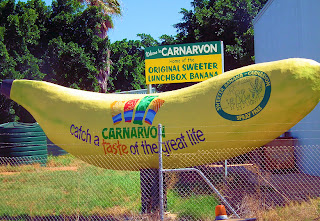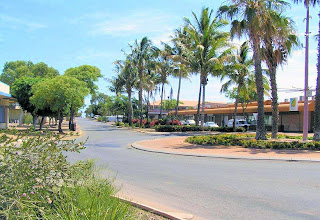The town was founded in 1883, initially as a port and supply centre for the sourrounding region. The town site was officially gazetted on 4 June, 1891 and named after Henry Herbert, 4th Earl of Carnarvon, Under-Secretary of State for the Colonies.
Original settlers in Carnarvon drove 4,000 sheep from York east of Perth seeking warmer agricultural land. By 1883, Carnarvon had enough settlers for it to be gazetted as a town. Some of Australia's largest sheep stations were set up and the jetty (1,493 metres) became the first port in Western Australia, and perhaps the world, to regularly export livestock.
Ships and then camels were used to transport supplies and stock; Carnarvon's roads are an impressive 40m wide in order to allow the long camel trains to turn and change direction whilst carrying a full load. Roads of similar width are also features of Kalgoorlie and Coolgardie, for the same reason. Today the wide streets of Carnarvon still remain with beautiful hibiscus, tall palms and bright bougainvilleas growing along them.
Carnarvon's hinterlands produce superb fresh fruit and vegetables; avocadoes, mangoes, pineapples, paw paws, melons, beans, dates, jojoba, macadamia nuts, tomatoes and pecans. The constant supply of water from the Gascoyne River helps row these crops, undoubtedly some of the best tasting produce in the world. Bananas in particular are, and always have been, one of the chief crops:
Although the crops are irrigated from the river, there is often no water to be seen in the Gascoyne River. This mighty river only runs underground for much of the year! (Hard to believe there is so much water under all that sand):
There are many sights to be seen in and around Carnarvon - the War Memorial:
The Space Station:
Magnificent palm trees (the colours are amazing):
Also some magnificent sunsets:
There are lots of other sights to see and things to do in and around Carnarvon but I've just given you a glimpse of some of them (courtesy Carnarvon Tourism Guide). In season the wildflowers are very beautiful as well.
In 2013 the town was menaced by a bushfire burning on the north-eastern side of the town. The fire burnt out of control with strong winds starting spot fires among the banana plantations. The blaze was controlled a day later but destroyed 1,400 hectares (3,500 acres) of bushland, including 20 derelict buildings and sheds; the banana plantations only received minor damage (which was fortunate for banana lovers).












What a beautiful place - and I am ashamed to say that I really knew very little about it. Thank you.
ReplyDeleteIt is so different to places down south I think they have a few problems up there but all in all a great place to visit. Glad you enjoyed Carnarvon.
DeleteOh I am a banana lover and happy the bananas survived. I was fascinated by the river that runs underground under the sand I have never heard of such a thing. Travelling around Australia with you is wonderful Thank you Hug B
ReplyDeleteWe in Australia also love our bananas. There are many rivers in Australia similar to the Gascoyne but when they are in flood it is an entirely different story. Ours is certainly a land of many contrasts. Glad you enjoyed your visit and thanks. xx
ReplyDeleteAlways fun to learn of these places, especially through these lovely photos. Happy day to you :)
ReplyDeleteI am glad you enjoyed your visit to Carnarvon. Happy day to you too. : )
DeleteP.S. Wish I had taken these photos but those I took all those years ago when we holidayed there were black and white and put away somewhere.
Underground rivers! Now there's a great idea. It would stop a lot of that pesky evaporation and low water levels.
ReplyDeleteCarnarvon looks like a wonderful place to visit. I love bananas.
Those rivers amaze me too but when they flood....beware!!! Bananas I think are favourites with everyone, child or adult. They have lots of potassium and carbs if you need a quick fix of sugar. We are not supposed to eat very ripe bananas as their sugar content is too high for diabetiics. We share a banana cut up on our cereal (or even porridge) every morning.
ReplyDelete